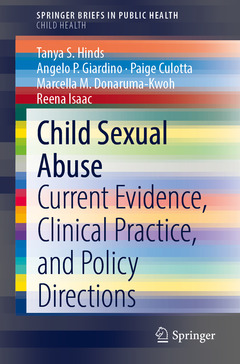Description
Child Sexual Abuse, 1st ed. 2020
Current Evidence, Clinical Practice, and Policy Directions
SpringerBriefs in Child Health Series
Language: English
Subjects for Child Sexual Abuse:
Keywords
child sexual abuse; sexual assault of children; sexual abuse; sexual victimization; assault; child rape; sexual abuse of minors; child maltreatment; child abuse; child sexual abuse prevention; forensic evidence; age of consent issues; rape trauma syndrome; adverse childhood experiences; traumagenic dynamics model; safe environment policies
122 p. · 15.5x23.5 cm · Paperback
Description
/li>Contents
/li>Biography
/li>Comment
/li>
This brief approaches the challenging topic of child sexual abuse from an objective, evidence-based perspective. It offers an overview of child sexual abuse, including definitions and a clear explanation of the epidemiology. The text also explores the conceptual frameworks that seek to explain how a child comes to be sexually abused by an adult or older adolescent.
In the chapters, the authors present credible prevalence and incidence studies that are used to provide a scientific response to how common this problem is. In addition, they address the policy implications for a myriad of prevention and treatment initiatives as well as related issues such as delayed reporting and the risk for sexual abuse within child serving organizations. Finally, the brief concludes with the authors' recommendations for the future on how best to prevent child sexual abuse in the first place. Prevention of child sexual abuse is very different than prevention of child physical abuse and neglect and requires a different framework and set of initiatives.
Child Sexual Abuse: Current Evidence, Clinical Practice, and Policy Directions is a must-have resource for a range of professionals including healthcare providers, child advocates, clinical social workers, public health officials, mental health providers, and legislative staff professionals. It also is written in a readable manner for members of the lay public.
Tanya S. Hinds, MD, MS, FAAP, is an Associate Professor of Pediatrics at the George Washington University School of Medicine and Health Sciences in Washington, DC and a board-certified Child Abuse Pediatrician. She is an Attending Child Abuse Pediatrician at the Child and Adolescent Protection Center at Children’s National Hospital in Washington, DC. In addition to patient care, Dr. Hinds serves as the course director of a Child Abuse Pediatrics elective for medical students. . Dr. Hinds is an active participant in the District of Columbia’s Multidisciplinary Team on Child Abuse. She is also a member of several national organizations including the American Academy of Pediatrics’ Section on Child Abuse and Neglect, the American Professional Society on the Abuse of Children, and the Ray E. Helfer Society. Dr. Hinds is part of several child maltreatment research and education efforts at Children’s National, lectures locally and nationally, and testifies in child abuse cases in the District of Columbia, Maryland, and Virginia.
Angelo P. Giardino, MD, PhD, MPH, is the Wilma T. Gibson Presidential Professor and Chair of the Department of Pediatrics at the University of Utah’s School of Medicine and Chief Medical Officer at Intermountain Primary Children’s Hospital in Salt Lake City, Utah. He received his medical degree and doctorate in education from the University of Pennsylvania, completed his residency and fellowship training at the Children’s Hospital of Philadelphia (CHOP), earned a Master’s in Public Health from the University of Massachusetts, a Master’s in Theology from the Catholic Distance University, and a Master’s in Public Affairs from the University of Texas-Rio Grande Valley. He holds subspecialty certifications in Pediatrics and Child Abuse Pediatrics from the American Board of Pediatrics. He is also a Certified Physician Executive (CPE) within the American Association for Physician Leadership. He completed the Patien
Approaches the challenging topic of child sexual abuse from an objective, evidence-based perspective, with a professional tone and orientation
Presents a framework and set of initiatives different from those used for the prevention of child physical abuse and neglect
Incorporates the growing body of evidence upon which current practice is based




